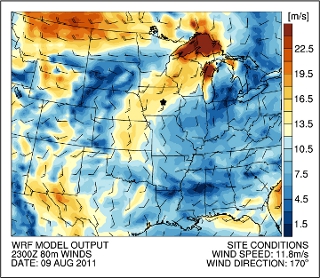Brian VanderwendeDepartment of Atmospheric and Oceanic Sciences |
||||||
Home |
Curriculum Vitae |
Teaching |
Research |
Programs |
Photos |
Contact |
Research OverviewI work in the Lundquist Research Group on outstanding questions in our understanding of the atmospheric boundary layer (ABL), with a focus on wind energy. Current ProjectsPulsed lidar performance comparison During the 2013 Crop/Wind Experiment (CWEX) field campaign, our research group deployed three Leosphere V1 Windcube profiling lidars along with a Leosphere 200S scanning lidar at a wind farm in central Iowa. The use of velocity-azimuth display (VAD) scans from the scanning lidar allows for comparison of each platform's wind profile performance. The scanning lidar is capable of wind measurement at heights well above the turbine rotor, enabling studies of important phenomena such as the Great Plains Low-Level Jet. Crop-height influence on the wind resource [Poster] Computer modeling allows us to address mechanisms that may be hard to quantify using real-world observations. For example, the height of agricultural crops can impact the amount of surface drag on the boundary layer wind field. In this project, I am using the Weather Research and Forecasting (WRF) model to investigate whether this drag can actually affect the amount of wind power available to colocated turbines. 
WRF performance in the turbine rotor layer [Presentation] One of the big questions for model users is which physics settings and input data should be used when running simulations. In this work, I evaluate a number of different settings while simulating the CWEX wind farm. These simulations are then compared to observations taken during the field campaign, to get a sense of which configurations outperform the others. Past ProjectsWind turbine performance and stability [Paper][Presentation][Poster] Past research has shown that wind turbine performance depends on atmospheric characteristics such as turbulence, wind shear, and stability. Unfortunately, at many farms the requisite suite of observations to quantify those phenomena are not available. In this study, we used turbine nacelle observations of wind speed to evaluate turbine performance compared to the manufacturer's specification in a range of stability regimes as measured by a remotely located meteorological tower. At the study wind farm, we found a measurable difference in turbine performance for stable vs. convective conditions. We evaluated the statistical robustness of our results and demonstrated the utility of nacelle wind speed measurements for meteorological inquiry. Full Publication ListVanderwende, BJ, JK Lundquist. 2012. The modification of wind turbine performance by statistically distinct atmospheric regimes. Environ. Res. Lett. 7 034035. doi:10.1088/1748-9326/7/3/034035 Noone D, C Risi, A Bailey, M Berkelhammer, DP Brown, N Buenning, S Gregory, J Nusbaumer, D Schneider, J Sykes, B Vanderwende, J Wong, Y Meillier, D Wolfe. 2012. Determining water sources in the boundary layer from tall tower profiles of water vapor and surface water isotope ratios after a snowstorm in Colorado. Atmos. Chem. Phys. Discuss. 12, 16327-16375. |
||||||
|
This website designed by Brian Vanderwende 2010. |
||||||